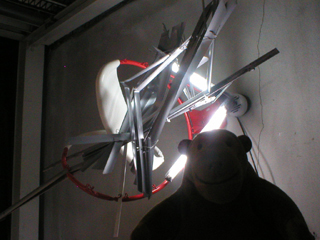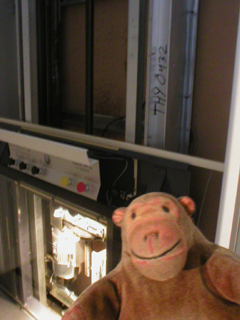Mr Monkey scampered along Deansgate to the Castlefield Gallery, to see
Born After 1924. This exhibition, curated by Ingo Gerken, features work by eight artists inspired by and responding to Kurt Schwitters' 1924 magazine
Merz Issue 8/9. The theme of the magazine was
nasci - 'being born' or 'becoming', hence the title of the exhibition. Mr Monkey looked at a 1975 reprint of the magazine then explored the exhibition.

Matti Isan Blind creates sites where the real and symbolic meet. In
Looking for a ride to your secret location he has loaded a desk with ritualistic and folk art objects, including what Mr Monkey considered an appalling misuse of that noble fruit, the banana. Halfway down the stairs,
Blind Spot looks just like a bunch of keys on top of a pile of magazines, until you watch the keys for a while and see that they move.
Madeline Boschan uses found objects, sprayed with car paint to combine them into a single piece.
Typewriter's Friend appears to be a fragment of a giant's typewriter but probably isn't. In a small side-room,
Ism isn't is similar but with lighting as well. Mr Monkey wasn't completely sure whether all the switches and fuses were part of the gallery or the installation.
Antonia Low has been allowed to dismantle the inside of the gallery lift to reveal the mechanics behind day to day life in the three part
LIFT series. All the panels have been removed from the lift interior and stored around the gallery, the screws and nuts that held the plates in place hang as a necklace beside the lift. Additionally a single panel has been fitted with a sheet of sponge through which oil is slowly seeping, to form
Vive la machine! Es lebe die Maschine!. Anyone using the lift can see bits of lift normally kept hidden, though perspex sheilds have been installed to prevent visitors getting their paws or tails entangled.
Besides inviting the other artists to contribute, Ingo Gerken has created
We die in the centre of the lower floor. Mr Monkey scurried around the piles of magazines surrounding a single office chair until he found a copy of the magazine that inspired the whole show.

Tim Noble & Sue Webster really impressed Mr Monkey with
TrasHeaD, in which a really carefully arranged heap of rubbish casts a shadow of the artists heads onto the wall. The shadow is astoundingly detailed - right down to eyelashes - and, of course, there's the opportunity for a small monkey to stage a temporary intervention. To Mr Monkey, this was a bonus that rounded off the exhibition nicely.
Not all the work photographed well. Rainer Ganahl has a series of reprints of New York Times obituaries of luminaries in the Dada movement framed around the gallery. The New York Times did not print an obituary of Kurt Schwitters; Mr Monkey suspects this is the point. Gregor Schneider has left what seems to be a dead man under the stairs, which is interesting but, according to Mr Monkey, nowhere near as interesting or disconcerting (or as big and dark) as
Die Kinderzimmer at the Whitworth in 2009. Reto Pulfer exhibits a strange garment, made adjustable by the addition of a zip, which didn't really convince Mr Monkey, and provides a sound track to the exhibition via a collection of instruments made from sticks, rods and wires


 Matti Isan Blind creates sites where the real and symbolic meet. In Looking for a ride to your secret location he has loaded a desk with ritualistic and folk art objects, including what Mr Monkey considered an appalling misuse of that noble fruit, the banana. Halfway down the stairs, Blind Spot looks just like a bunch of keys on top of a pile of magazines, until you watch the keys for a while and see that they move.
Matti Isan Blind creates sites where the real and symbolic meet. In Looking for a ride to your secret location he has loaded a desk with ritualistic and folk art objects, including what Mr Monkey considered an appalling misuse of that noble fruit, the banana. Halfway down the stairs, Blind Spot looks just like a bunch of keys on top of a pile of magazines, until you watch the keys for a while and see that they move. Tim Noble & Sue Webster really impressed Mr Monkey with TrasHeaD, in which a really carefully arranged heap of rubbish casts a shadow of the artists heads onto the wall. The shadow is astoundingly detailed - right down to eyelashes - and, of course, there's the opportunity for a small monkey to stage a temporary intervention. To Mr Monkey, this was a bonus that rounded off the exhibition nicely.
Tim Noble & Sue Webster really impressed Mr Monkey with TrasHeaD, in which a really carefully arranged heap of rubbish casts a shadow of the artists heads onto the wall. The shadow is astoundingly detailed - right down to eyelashes - and, of course, there's the opportunity for a small monkey to stage a temporary intervention. To Mr Monkey, this was a bonus that rounded off the exhibition nicely.